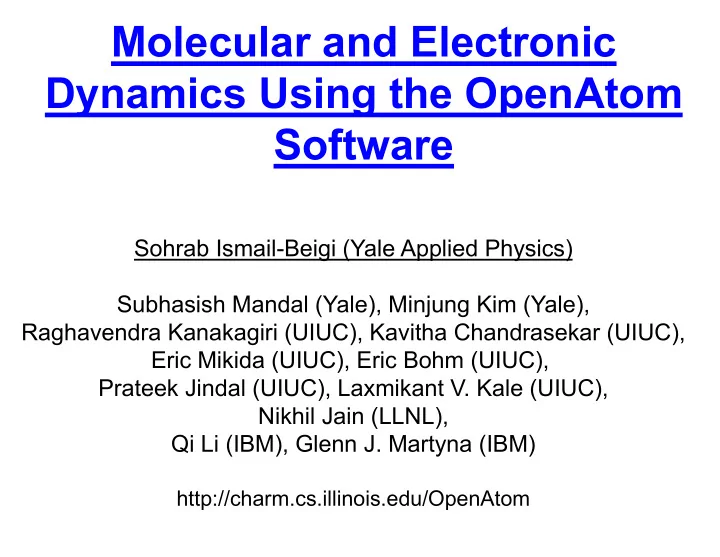

Molecular and Electronic Dynamics Using the OpenAtom Software Sohrab Ismail-Beigi (Yale Applied Physics) Subhasish Mandal (Yale), Minjung Kim (Yale), Raghavendra Kanakagiri (UIUC), Kavitha Chandrasekar (UIUC), Eric Mikida (UIUC), Eric Bohm (UIUC), Prateek Jindal (UIUC), Laxmikant V. Kale (UIUC), Nikhil Jain (LLNL), Qi Li (IBM), Glenn J. Martyna (IBM) http://charm.cs.illinois.edu/OpenAtom
What is OpenAtom Sohrab Ismail-Beigi Sanjay Kalé Glenn Martyna Applied Physics Computer Science Physical Chemistry & Materials UIUC & Materials Yale IBM NSF SI2-SSI: Scalable, Extensible, and Open Framework for Ground and Excited State Properties of Complex Systems • OpenAtom software package : DFT , GW • Plane waves and pseudopotentials • charm++ parallel infrastructure
OpenAtom: what does it do? • Massively parallel ab initio molecular dynamics (AIMD) • Excited electronic states (Green function methods) • Describes electrons quantum mechanically, i.e., bonding, explicitly using basic physics (no fudge parameters or fits) • Uses general Fourier basis to represent electron waves • Uses Charm-FFT library : 2D decomposed parallel FFT with spherical cutoff awareness For the experts: • Plane waves , pseudopotentials , LDA or GGA • Car-Parrinello and Born-Oppenheimer MD of electronic ground state • GW self-energy for electronic excitations
Overview • What is OpenAtom? • We are studying metal organic frameworks (MOFS) o What is a MOF? o Why study hydrogen in MOFs? • What we learned so far on MOFs • Improving large scale GW calculations
Hydrogen storage for green energy • Hydrogen as fuel o energy dense o clean burn o hard to store • Need lightweight material that stores and releases a lot of H 2 • Metal organic frameworks (MOFs) http://energy.gov/eere/fuelcells/hydrogen-storage o Porous DOE target for a H 2 storage system not yet o Large interior surface area been reached: e.g., capacity of 40 g H 2 per L. o Stores plenty of H 2 o Complex material, details of process not known o Optimization of H 2 storage not great to date
Typical MOF structure
MOFs we study • MOF-5 : Zn 4 O(1,4 benzenedicarboxylate) 3 • 424 atoms in a simulation cell • Can change Zn to other metals Questions to answer: • How do H 2 bind / diffuse inside MOF? • Temperature & loading dependence Molecular dynamics (MD) needed • Simulate motion of MOF + H 2 to see what happens in real time • Dynamics & thermodynamics Technical challenge: H 2 is very light • Standard MD: point-like atoms move due to interatomic forces • Hydrogen is quantum mechanical : not point-like but wavy …
Difficulties: quantum nuclei • Quantum nuclear module validated/tested in serial • Quantum nuclear module validated/tested on small parallel calculations we can do locally • Quantum nuclear for large MOF with many nodes and “beads” (quantum replicas) fails on BW at present (need to run ~1000 nodes for ~3 hours to reach failure) • Some type of irreproducible parallel problem • ~9 months of work and bug removal has narrowed it to a single module but not isolated yet • General problem : how to validate/test parallel code when only possible on a computer as big as BW? How to know code is correct before BW allocation?
Overview • What is OpenAtom? • We are studying metal organic frameworks (MOFS) o What is a MOF? o Why study hydrogen in MOFs? • What we learned so far on MOFs • Improving large scale GW calculations
Preliminary results: MD itself
Preliminary results: diffusion Paths of H 2 molecules over simulation (a) (b) Heatmap: mean H 2 positions Diffusive paths followed by MOF with 43 H 2 mini-MOF with 6 H 2 in simulation cell H 2 molecules over time z-axis (Å) z-axis (Å) x-axis (Å) x-axis (Å)
Preliminary results: diffusion Heatmap: mean H 2 positions in simulation cell 0.9 0.8 0.7 0.6 0.5 0.4 0.3 0.2 0.1 0.1 0.2 0.3 0.4 0.5 0.6 0.7 0.8 0.9
Preliminary results: diffusion 7 6!2 = 5 2 − ⃗ ⃗ 5 0 (for long times t ) • Slope of black curve: ! ≈ 8.5 ± 0.5 × 10 *+ , - . • Seems to agree with available literature ! ≈ 7×10 *0 , - . J. Phys. Chem. C 2008, 112, 2911-2917
Preliminary results: diffusion Mini-MOF Full MOF D ( 10 -8 m 2 /s ) 77 K 1.1 � 0.2 0.85 � 0.05 300 K 6.9 � 0.8 3.5 � 0.4 ratio 6.3 4.1
Overview • What is OpenAtom? • We are studying metal organic frameworks (MOFS) o What is a MOF? o Why study hydrogen in MOFs? • What we learned so far on MOFs • Improving large scale GW calculations
DFT: problems with excitations Energy gaps (eV) Material LDA Expt. [1] [1] Landolt-Bornstien, Diamond 3.9 5.48 vol. III; Baldini & Bosacchi, Phys. Stat. Si 0.5 1.17 Solidi (1970). LiCl 6.0 9.4 Solar spectrum
GW : scaling
GW : scaling Scaling'on'Mira' Scaling/on/BlueWaters/ 1000 10000 32/cores/per/node 32'threads'per'node 1000 Time'(Sec) 100 Time(Sec) 100 10 10 OpenAtom BerkeleyGW1.2 OpenAtom BerkeleyGW1.2 1 1 1 10 100 1000 10000 1 10 100 1000 10000 Number'of'Nodes Number/of/Nodes
GW : scaling ! "# = % " × % # for all v,c ) for all f ' += ! "# × ! "#
Summary • Study metal organic frameworks (MOFS) for H 2 storage • Used OpenAtom on Blue Waters • Preliminary non-quantum simulations o Seem reasonable o Must be mined for more physical insight o Next 3 months: finalize analysis of MD results • GW part in OpenAtom: scaling greatly improved on BW ready for pubic release
Recommend
More recommend